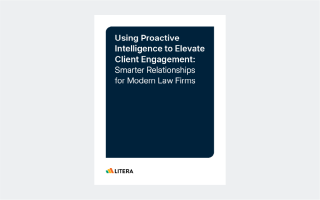The Document Lifecycle: Making Legal Documents Better
We've all seen them: embarrassing and perhaps financially costly mistakes in important documents. We wince at others' misfortune while simultaneously breathing a sigh of relief: at least it wasn't us! But how do you know it won't be next time? As a legal professional, every document you create is important and, not to be overly dramatic, any mistake could spell the end of your career. Contracts define the rights and responsibilities of parties with legally binding conditions. Complaints, petitions, motions, and responses frame your arguments, potentially limiting the relief your client may receive or increasing the penalty that client might owe. Even memoranda only intended for 'internal' use often form the basis for later client- and court-facing documents. Yet too many lawyers are so pressed for time that they aren't doing a good job with their document lifecycle management. We believe that focusing on the total document drafting lifecycle and using the best drafting software is the key to streamlining workflows and improving individual documents, thereby building a reputation for yourself and your firm as careful, consistent, and detail-oriented. How? Let's first look at what we mean by the document lifecycle.
What is The Document Lifecycle?
In essence, the document drafting lifecycle offers a holistic view of how legal professionals generate final documents from creation, to proofreading, to review from partners. In that process, documents are initially created or drafted, then checked over thoroughly for both proofreading and formatting errors, and finally reviewed in collaboration with partners. Thinking through all stages of the document lifecycle ensures that the resulting documents are:
- clear, understandable, and accessible, free from arcane legalese or meaningless boilerplate;
- complete and comprehensive, including every necessary argument or clause while omitting extraneous or irrelevant information;
- correct in their statements of the law and the facts applicable to this specific matter;
- up to date in their citations and references;
- consistent in their format and styling, meeting court rules and firm conventions; and
- free from errors.
Just as importantly, an effective document lifecycle allows legal professionals to create these impeccable documents quickly and easily, without reinventing the wheel or wasting time on repetitive or mindless tasks. Lawyers spend 60% of their time drafting documents; improvements to this one task can cause a substantial ripple effect. Leveraging previous work and integrating seamlessly with legal workflows, a well-tuned document lifecycle maximizes legal professionals' time on high-value work and enhances workplace satisfaction.
The Four Steps of the Document Lifecycle
1. Create - The first step is creating a draft of your document. Adding in all the necessary precedents and clauses, styling for your firm, and generating the document so it's ready to share.
2. Check - Once the draft is created, it's time to check for technical and legal structure. Make sure all numbering and formatting issues are resolved and the entire document is proofread for legal errors.
3. Collaborate - During the negotiation stage, a document is going to be shared, updated, and collaborated on. Ensure that no details are missed in the transfer of the document. It's also important to make sure that sensitive information is encrypted during distribution. Tracking and managing changes is necessary before the final step.
4. Publish - Once your document is ready for it's final version, it's time to convert into a PDF. Compress the file size, add to the correct folders, and remove the sensitive content, and then you'll be ready to publish the final version of your document with peace of mind.
Focusing on the Total Document Lifecycle Improves Individual Documents
Create better documents. Most attorneys already start documents based on preexisting templates or examples from similar cases. While repurposing saves time, it can be fraught with errors. Something as small as forgetting to replace 'he' with 'she' throughout a contract can leave a client wondering whether you were really paying attention to her specific case'or what else you missed. With automated software to shepherd documents from creation through checking and collaboration, you can eliminate these creation errors.
Check everything. Similarly, software that automatically proofreads your documents and draws your attention to key clauses by comparing a document with other examples can save time and improve results. We've surveyed legal professionals and found that as many as one in three don't have time to proofread their documents. Wraparound document lifecycle solutions can do the heavy lifting for you during the checking phase, highlighting both proofing errors and formatting inconsistencies.
Collaborate seamlessly. Nothing is created in a vacuum today; collaboration with partners is the key both to producing excellent individual documents and to building a library of document examples. But all too often, file versions spiral out of control during collaboration efforts. Reviewers may start from different versions of a draft or may not see suggestions made by other collaborators. Standard word processing software struggles to keep up with formatting and tracked changes for lengthy, complex documents, like one's going through the contract lifecycle. These mistakes can be amplified when a 'final' document that didn't incorporate all of the previous collaborators' corrections is then used as the template for a new document.Don't be the attorney whose complaint was so horrendous that the court ordered him to 'certif[y] the pleading has been reviewed and approved by a teacher of the English language' before refiling. If you're wasting too much time trying to produce error-free documents, we can help.




